Text
A Lake of the Pines Flora
Check out the document that I was working on in 2011, basically the book which this blog has become! (You may need a scribd account to download the pdf?) Anyways check it out!
http://www.scribd.com/doc/210670176/A-Lake-of-the-Pines-Flora
I wrote the document and took the photos while staying with my parents at their home in "LOP" that year, I was working for the Tahoe National Forest as a seasonal botanist- therefore my interest in the subject! Actually I was inspired one afternoon while riding my bicycle around the lake and observing the landscaping along with the oaks pines and manzanitas which occur there naturally. It was interesting to me then, as it is now, how as humans we are able to manipulate our landscape, without ever being able to escape the 'natural' order of which we are part of. As home/landowners, we are able to bend and re arrange our space, and to that end we can either work with or fight the dominant, native ecological systems in which we are part.
I hope that whoever does come across this blog will taking something useful from it!
Peace
Eric
0 notes
Text
Scotch Broom
Scotchbroom, Cytisus scoparius, is a shrub belonging to the Pea family, Leguminoaseae. It can grow up to 15 feet in height, has long dark green stems and small, barely noticeable three parted leaves. It has bilateral flowers which are bright yellow and consistent with other legume flowers, with a banner(upper petals), keel (lower petal), and wings on the each side. Rarely the flower will have a strong sweet smelling fragrance. Fruits are seed pods, green to black and fuzzy, 1-2” in length. Seed pods burst open upon maturity, a botanical process known as dehiscence.
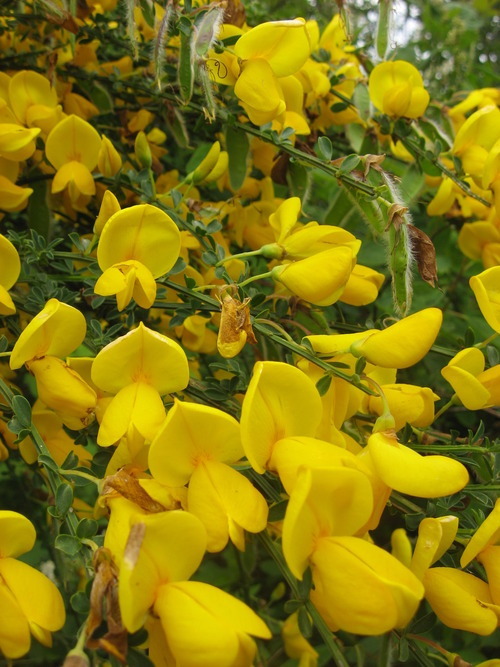
Scotch Broom is native Europe and has become the most devastating non-native, invasive plant to our local bio-region’s health in the past decade. Local campaigns have raised awareness of the negative impact of Scotch Broom to natural resources. In the springtime you can see its prolific yellow blooms along many Nevada county road systems. a habitat where it is most commonly found. In the
past half century it has expanded its range rapidly, invading Highway 49 north of Nevada City, creating a very dense understory creating a fire hazard. Scotch broom does very well at out competing and crowding out native shrubs and forbes which decreases biodiversity and overall ecological health. Native insects
and wildlife do not consume this plant either, due in part to the very high silica content that it contains, which is mostly indigestible to mammals.
There are several other species commonly referred to as “Broom”. French Broom, Genista monspessulana is distinguished by its smaller flowers and fruits. Spanish Broom, Spartium junceum has rounded stems, compared to square stems of Scotch and French Brooms. It has small inconspicuous leaves which give it a skeleton-like appearance.

1 note
·
View note
Text
Sycamore
Sycamore are large trunked deciduous trees belonging to the Sycamore Family, Platanaceae. Western Sycamore, Platanus racemosa, grows to heights of 40-80’, with a diameter of 2-4’. Western Sycamore has a whitish smooth bark, which peels off in large brown flakes, leaving a mottled dark gray to brown appearance on its trunk. Its leaves are simple, star shaped or palmately lobed 3-5 times, and
fairly large at 6-9” inches across. The leaves are borne on leafstalks, are light green above and pale hairy beneath. Sycamore flowers are monoecious, borne in the spring into ball-like clusters of 2-4 “heads” less than 1 inch wide. These flowers become golden hairy “fruits” in autumn, falling to the ground by winter time. These flowers and fruits are fairly unique, the only comparable tree found in
our area is Sweetgum, which Sycamore may be confused with. One key to distinguishing Sycamore from Sweetgum or Maple trees is its peeling bark, and golden hairy leaves and fruits. Sycamore trees are associated with riparian habitats, in canyons from the coast to foothills. It can be found in Lake of
the Pines growing at Park 2 among other locations.

Sycamore foliage

Trunk of Platanus racemosa
0 notes
Text
Eucalyptus
Eucalyptus trees, of which there are many species, are large naturalized trees and shrubs native to tropical regions of the planet, most notably Australia. There are more than 700 species belonging to the genus Eucalyptus, which is a member of the Myrtle Family, Myrtaceae. Eucalyptus are common to the coastal regions of California, and their unique odor is familiar to anyone who has spent time in San Francisco. Eucalyptus or “Gum” trees are very well suited for California’s Mediterranean climate. Eucalyptus was planted for timber products, and used heavily deforested areas upon California's development.
Eucalyptus are less common in our region of the Sierra Nevada Foothills, and are not recommended for landscaping use, since they become quite invasive once established.

0 notes
Text
Cottonwood
The other major genus of trees found in our area belonging to the Willow Family is Populus, which contains the Cottonwoods, Poplars, and Aspens. Like Salix, Populus species have deciduous leaves, although their shape is broadly triangular compared to the linear Willow leaves. Populus species have male and female catkins which appear in early spring and borne on separate trees. Fruits are eggshaped
capsules which split into three parts releasing many cottony seeds. Fremont’s or Western Cottonwood, Populus fremontii is a large broad crowned tree, with thick
furrowed gray bark, growing to 40-80’ in height. It has 2-3” broad leaves with finely toothed margins, which are green during spring and summer becoming bright yellow by autumn. It is commonly found growing near river valley bottoms in the Sierra Nevada Mountains, and can be seen around Lake of the Pines.
Quaking Aspen, Populus tremuloides, is found growing in stands at higher elevations of Tahoe National Forest, creating unique habitats.

0 notes
Text
Willow
Willows are deciduous, flowering trees and shrubs belonging to the two main genera Salix and Populus, members of the Willow Family, Salicaceae. There are over 57 genera worldwide, concentrated mainly in temperate and arctic regions of the northern hemisphere. Members of the Willow Family have simple
alternate leaves which appear in the springtime and become bright red, orange, and yellow before falling off in autumn.
Their flowers are catkins, with most species being dioecious, male and female
flowers borne on separate individuals. The fruit of Salicaceae species are capsules opening in 2-4 parts, containing many tiny seeds with cotton-like hairs. Willows, Poplars, and Cottonwoods are often midsized trees, with heights on the scale of 10-80 feet. Their bark can vary from gray to brown, becoming furrowed in older individuals. Willows are strongly associated with riparian habitats, as they
are most commonly found in wet soils near creek systems, and may be found in dense stands on riverbanks in healthy riparian ecosystems.
Salix – Willows
The Genus Salix contains more than 300 species of deciduous trees and shrubs worldwide. Willow species have linear leaves, which are simple, alternate, and entire. Depending on species, Willow leaves can be less than 1 to more than 6 inches in length, less than 1 inch wide. Willow flowers form in early spring at the same time or before the leaves appear. Its flowers are catkins generally 1-2” in length, borne on the end of leafy twigs, often with white or yellow hairs. Female catkins are borne on separate plants, and are a similar size to male catkins. Since Willow species are dioecious, cross fertilization is possible creating hybrid varieties unique to a specific area. Willow fruits are capsules which can also be hairy. Willow bark and leaves contain salicylic acid, which is a historical cure for pain.
This compound has since been isolated by western science and is an active ingredient of Aspirin. One common species of Willow in Lake of the Pines is Sandbar Willow, Salix exigua, which is found growing naturally along our creek pond banks. In its mature state, it reaches heights of 10-25 feet and grows in dense colonies, as it spreads laterally by basal shoots. It has male and female catkins
of about 3 inches in length, with capsules containing many seeds embedded in shiny white silk. Another well known variety is Weeping Willow, Salix babylonica, which is a Chinese cultivar. Weeping Willow has a large broad crown of drooping branches. It has 2-5” leaves, which are ½” wide, lance shaped, dark green above and whitish below. It has a thick gray bark, deeply furrowed, 2 or more feet in
diameter, and growing to heights of around 40 feet. Weeping willow is often found at the edges of ponds in wet soils, one can be seen across the pond at the front gate of Lake of the Pines.

0 notes
Text
Redbud
Cercis occidentalis
Pea Family(Leguminoaseae)

4 notes
·
View notes
Text
Birch
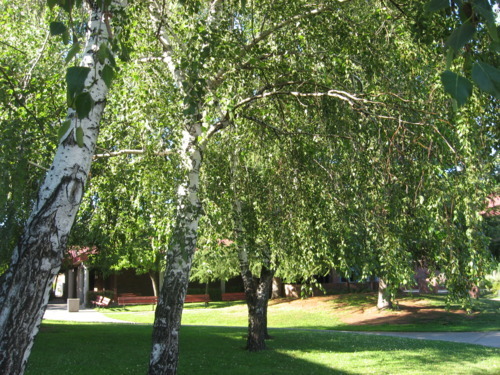
Birch trees can be found planted within the Lake of the Pines community, which belong to the Birch Family, Betulaceae. Also within this family is Sierra Alder, Alnus rhombifolia, a small tree found growing from perennial streams in the Sierra Nevada, although not within Lake of the Pines. Birch are attractive trees, 50-70’ tall and 1-2’ wide with white, papery bark. Native to most other areas north and east of California on the continent, Birch species are propagated here for their ornamental value. Birch have ovate leaves with saw toothed margins, 2-4” long. Their simple alternate leaves are dark green above and lighter green below, and turn yellow in the autumn before falling. Birch trees are monoecious, with male catkins yellowish and drooping at twig tips, female catkins are greenish and upright further back on the same twig. Both are very small and appear in early spring. Birch cones are brown, 1-2” long, and narrowly cylindrical. Cones mature in autumn to release many 2-winged seeds. Birch occupy open forests and moist soils, and in our area can survive most places if irrigated. Birch wood, such as that from Paper Birch, Betula papyrifera, has been used by Native Americans and European settlers alike for pulpwood.
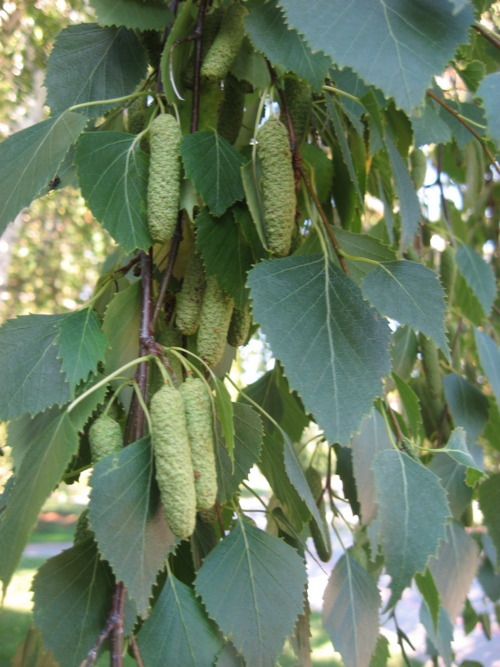
7 notes
·
View notes
Text
Magnolia
Magnolia are remarkable trees of which there are many species belonging to the genera Magnolia, which belongs to the family Magnoliaceae.

Southern Magnolia, Magnolia grandiflora, is a species native to the south eastern United States which can be found as a landscaping tree in our area, with one located near the Main Beach at LOP. Magnolias can be deciduous or evergreen, and have large (5-8”) ovate leaves which appear shiny and leathery. Their flowers may be their most dramatic feature as they are literally huge compared to the other trees mentioned in this guide. Southern Magnolia flowers have large white petals, with a sweet scent. The flowers may be 12 inches across. The fruit of this tree is a 4 inches long, ovoid shaped, and reddish in color.
4 notes
·
View notes
Text
Thuja
Thuja is a genus of evergreen coniferous trees belonging to the Cypress Family, Cuppressaceae. There are only 5 species of Thuja worldwide, 2 from North America and 3 from Asia. In the Pacific Northwest Coast region of the US, Western Redcedar (Thuja plicata) is an important member of coastal and interior forests, especially in Washington and British Columbia. This species has played a very important role to native Americans, who had varied uses for the tree in their mostly fiber based economy.
Thuja can vary in size, from only 20 feet in ornamental settings to well over 200 feet in old growth forests. All species have soft,stringy, reddish brown bark which can be an easy identifying feature. Their leaves are scale like and found in 4 rows along its stem. Their foliage has a distinctive smell when crushed. Male cones are very small and borne on the end of twigs. Female cones start out small and grow to 1/2 inch in size, maturing in 6-8 months.
In our region of Lake of the Pines, Thuja species are commonly referred to as Arborvitae, or Tree of Life. Arborvitae can grow several feet per year when young. makes an excellent ornamental tree for homeowners, often used as hedges or barrier trees to provide privacy. It generally grows to be a mid sized tree, up to 50 feet. "Green Giant" Thuja is a popular cultivar for its use as a fast growing privacy screen, and its deer resistance. It has soft scale like leaves, very similar in structure and smell to other Cypress trees, and could be easily misidentified for juniper and/or cedar leaves.
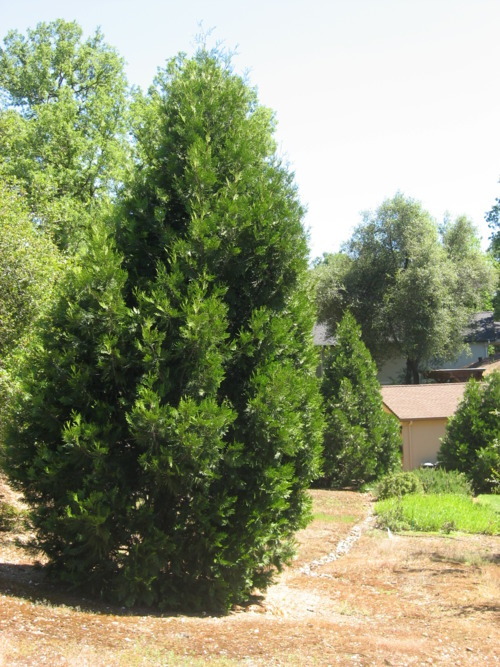
9 notes
·
View notes
Text
Tree of Heaven
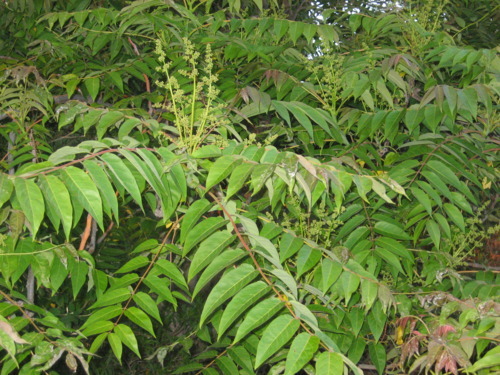
Tree of Heaven, Ailanthus altissima, is a non-native deciduous tree found throughout the Gold Country region of the foothills belonging to the mostly tropical family Simaroubaceae. Tree of Heaven is a direct legacy of the very thousands of Chinese who came to this area during the Gold Rush. It was originally brought by Chinese laborers who worked and lived in Northern Mine and railroad camps, and most likely planted by them as a reminder of home. It is a fast growing tree, reaching heights of 50 feet in only 25 years. It has smooth, light gray bark. It has compounded leaves, with 10 or more pairs of pointed ovate-lanceolate leaflets 2 to 7 inches long. The leaves are green and often with reddish hues. The leaves have a distinct, slightly unpleasant (to me) smell when crushed. Tree of Heaven is dioecious, with male trees producing several times more flowers than females. Its inflorescences are panicles of many (50 or more) small white flowers. Upon fertilization female trees produce winged fruits 1 inch in length, which may persist on the tree through the winter. Female trees are prolific seed producers, around 14,000 seeds per pound. Tree of Heaven can be seen growing from roadside ditches as well as dry areas, and it reproduces from new stem growth, or ‘suckers’. In Nevada County as well as other Gold Country areas tree of heaven has become a noxious tree for its tendency to displace native trees and shrubs and invade disturbed sites, such as the abandoned mines and railways where it was first introduced.
#tree of heaven#Ailanthus altissima#lake of the pines flora#lop#Bear River Flora#Nevada County trees#Nevada County Flora guide
3 notes
·
View notes
Text
Populus
Willows are deciduous, flowering trees and shrubs belonging to the two main genera Salix and Populus, members of the Willow Family, Salicaceae. There are over 57 genera worldwide, concentrated mainly in temperate and arctic regions of the northern hemisphere. Members of the Willow Family have simple alternate leaves which appear in the springtime and become bright red, orange, and yellow before falling off in autumn. Their flowers are catkins, with most species being dioecious, male and female flowers borne on separate individuals. The fruit of Salicaceae species are capsules opening in 2-4 parts, containing many tiny seeds with cotton-like hairs. Willows, Poplars, and Cottonwoods are often midsized trees, with heights on the scale of 10-80 feet. Their bark can vary from gray to brown, becoming furrowed in older individuals. Willows are strongly associated with riparian habitats, as they are most commonly found in wet soils near creek systems, and may be found in dense stands on riverbanks in healthy riparian ecosystems. Other Willows and Cottonwoods may be found further from rivers with large, spreading crowns.
Salix – Willows
The Genus Salix contains more than 300 species of deciduous trees and shrubs worldwide. Willow species have linear leaves, which are simple, alternate, and entire. Depending on species, Willow leaves can be less than 1 to more than 6 inches in length, less than 1 inch wide. Willow flowers form in early spring at the same time or before the leaves appear. Its flowers are catkins generally 1-2” in length, borne on the end of leafy twigs, often with white or yellow hairs. Female catkins are borne on separate plants, and are a similar size to male catkins. Since Willow species are dioecious, cross fertilization is possible creating hybrid varieties unique to a specific area. Willow fruits are capsules which can also be hairy. Willow bark and leaves contain salicylic acid, which is a historical cure for pain. This compound has since been isolated by western science and is an active ingredient of Aspirin.
One common species of Willow in Lake of the Pines is Sandbar Willow, Salix exigua, which is found growing naturally along our creek pond banks. In its mature state, it reaches heights of 10-25 feet and grows in dense colonies, as it spreads laterally by basal shoots. It has male and female catkins of about 3 inches in length, with capsules containing many seeds embedded in shiny white silk.
Another well known variety is Weeping Willow, Salix babylonica, is a Chinese cultivar. Weeping Willow has a large broad crown of drooping branches. It has 2-5” leaves, which are ½” wide, lance shaped, dark green above and whitish below. It has a thick gray bark, deeply furrowed, 2 or more feet in diameter, and growing to heights of around 40 feet. Weeping willow is often found at the edges of ponds in wet soils, one can be seen across the pond at the front gate of Lake of the Pines.

Populus – Cottonwoods
The other major genus of trees found in our area belonging to the Willow Family is Populus, which contains Cottonwoods, Poplars, and Aspens. Like Salix, Populus species have deciduous leaves, although their shape is broadly triangular compared to the linear Willow leaves. Populus species have male and female catkins which appear in early spring and borne on separate trees. Fruits are egg-shaped capsules which split into three parts releasing many cottony seeds.
Fremont’s or Western Cottonwood, Populus fremontii is a large broad crowned tree, with thick furrowed gray bark, growing to 40-80’ in height. It has 2-3” broad leaves with finely toothed margins, which are green during spring and summer becoming bright yellow by autumn. It is commonly found growing near river valley bottoms in the Sierra Nevada Mountains, and can be seen around Lake of the Pines. Quaking Aspen, Populus tremuloides, is found growing in stands in wet soils at higher elevations of Tahoe National Forest, creating unique habitats.

47 notes
·
View notes
Text
Sweetgum
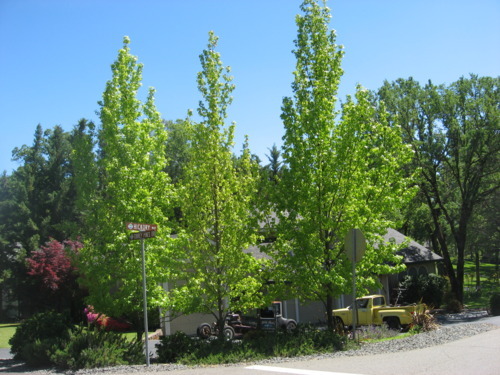
Another common tree which has been used extensively as a landscaping tree in our area is Sweetgum, Liquidambar styraciflua. There are 2 native Liquidambar species in the US, which belong to the Witch-Hazel family, Hamamelidacea (recently treated as Altignaceae). Sweetgum grows straight and tall, 50 to 100 feet in height, with a conical crown. Its bark is gray, and furrowed into ridges, and not especially wide at 1-3 feet in diameter. Sweetgum is a deciduous tree with bright green maple-like palmate leaves 3 to 6 inches in length. I had mistaken this tree for a maple (Acer sp.) for some time due to the similar leaf structure which become reddish yellow in the fall. Its flowers are tiny greenish red ball-like clusters, male stamens and female pistils separate. The fruit created from pollinated female flowers, are spiky 1 inch drooping woody-brown balls which contain many seeds. These “gumballs” persist on the tree into the winter when the tree has become dormant, and superficially resemble Sycamore fruits (Platanus sp.) The gum or sap of this tree which can be found in the furrows of the bark was used medicinally and as a chewing gum substitute. The leaves give off a pleasant, sweet odor when crushed, which is another identifying characteristic.

18 notes
·
View notes
Text
Prunus
The genus of Prunus contains more than 400 species of flowering shrubs and trees and is part of the Rose Family, Rosaceae. The Genus contains the Cherry, Plum, Peach, Nectarine, and Apricot trees along with many other wild species. Collectively these are known commonly as the “Stone Fruits”. The Stone Fruit trees grow from heights of 10-50 feet, and have smooth, red to gray stems when young, which become rough with age. Some species have thorns. Most Prunus species are deciduous, with simple alternately arranged leaves. The leaves have petioles, are ovate, with linear venation and minutely toothed margins. The leaves are often lighter green beneath than above, and depending on species, anywhere from 1 – 4inches in length. The flowers are 5 petaled, with 5 sepals, and as with most Rose types, with many stamens. The flowers can be borne singularly or in clusters along the stems. Flower color is usually white, or some variation of pink to red, and usually no more than 1 inch across. The fruit is technically classified as a drupe, which is a single, hard coated seed enclosed within a fleshy outer protection, which is the delicious fruit that we know and love. The flowers generally bud and open up in the wintertime, before any leaves have developed. There are many varieties of Prunus found, often bred for different characteristics, leaving this to be a fairly variable Genera.

The native Bitter Cherry, Prunus emarginata, which is not found growing wild in Lake of the Pines but is found at higher elevations in the Sierra Nevada has gray stems and white flowers. This wild variety produces a small cherry like fruit, which as its common name implies, is edible but not especially choice.
A common landscaping variety is Prunus cerasifera, commonly called Purple leaf plum. This tree which is native to Europe grows to heights of 30 feet actually has dark burgundy colored leaves, and is used as a landscaping tree for this purpose rather than for its fruits.
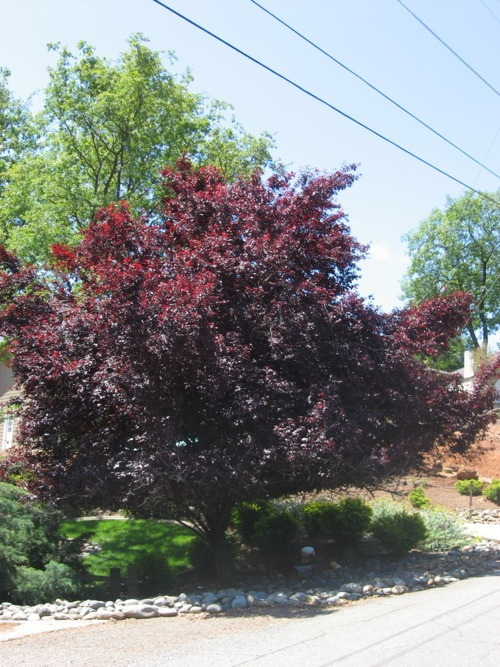
4 notes
·
View notes
Text
Photinia
Photinia is a genus of flowering shrubs and trees belonging to the Rose Family (Rosaceae). There are over 40 species worldwide, which are mostly native to Eastern Asia, and have been widely cultivated in worldwide for their ornamental value. Photinia generally vary in height from 10 – 30 feet with many light colored stems. The growth structure also can vary, as it will grow taller and more loosely if left uncut, but is often seen pruned to attain a very dense, hedge form. Photinia leaves are glossy green, ovate in shape, alternately arranged and generally 1 inch wide and 2 or more inches long. It can be deciduous, although many of the ornamental varieties found in Lake of the Pines are evergreen. New growth leaves are often red, in contrast to the dark green older leaves, which is a good identifying feature. This will be most evident in maintained, shrubby individuals. Photinia inflorescences are white, and borne on dense terminal clusters known as corymbs. The individual flowers are small, less than ½ inch across, and have 5 rounded petals, and there are often many flowers per corymb. The flowers have a distinctive mildly sweet aroma in the springtime, and during a bicycle ride around the Lake in May you will undoubtedly notice its prolific blooms. The fruit is a small red pome, which is inedible to humans but a foodsource for birds.
Photinia is one of the most popular landscaping trees in our area, for its attractive white blooms and reddish leaves. Homeowners and commercial landscapers alike choose Photinia since it is well adapted to survive in our climate and deer do not browse its leaves.

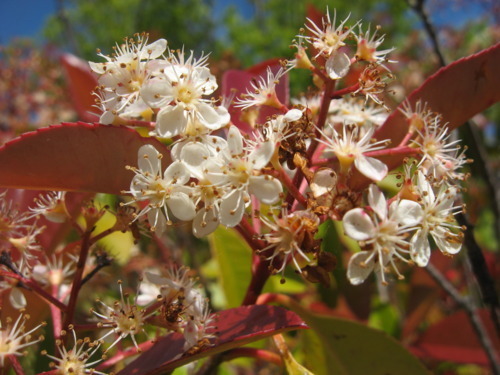
1 note
·
View note
Text
Firethorn
Another common shrub or small tree belonging to the Rose Family found in our area is Narrowleaf Firethorn, Pyracantha angustifolia. It grows from heights of 6 feet to well over 20 feet and has thorns. It has simple entire lanceolate leaves, which are dark shiny green, and alternately arranged. It has dense clusters of white small white flowers along its stems, which resemble Photinia flowers, as they are closely related. The flowers turn into bright red or orange pome fruits by late summer, and these fruits are eaten by birds which help propagate this species. The leaves and fruits contain cyanide, giving it a very bitter taste to humans. Native to China Pyracantha species have been propagated as ornamental trees in North America, and has become an invasive plant in tropical climates.

0 notes
Text
Catalpa
Catalpa is a medium sized deciduous tree that grows up to 60 feet tall and 20 feet wide. It belongs to the Trumpet Vine family, Bignoniaceae. There are two species of Catalpa native to subtropical North America, the rest of the genus is distributed in tropical regions of the Caribbean and East Asia. They can be recognized in our area by their large heart shaped leaves, which are 5-10 inches across. Catalpa flowers are showy, white, and tubular, 1-2 inches across, often with yellow within the flower tube. Another unique feature of Catalpa are its very long fruits which are 10 inch long pods, resembling giant peas. These pods may persist on the tree into winter. Each pod contains many light brown, winged seeds, which are released as the pod dehisces or “opens up” when ready. Catalpa has been propagated for its ornamental value as a shade and wildlife tree and due to its strange fruits. Several individuals can be found in Lake of the Pines, and it is fairly commonly found in the Sacramento Valley and Sierra Nevada Foothills.

22 notes
·
View notes